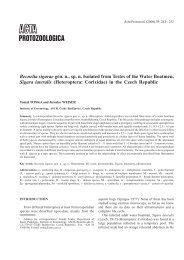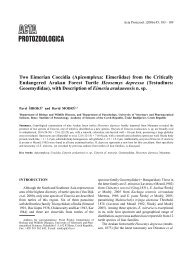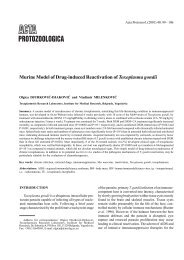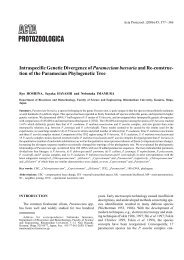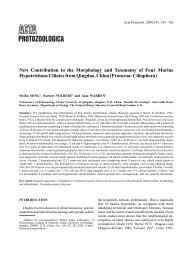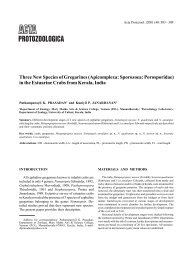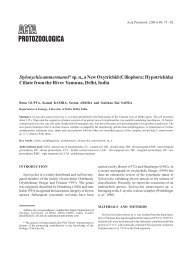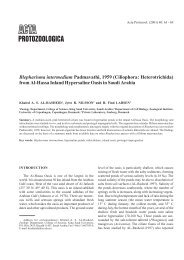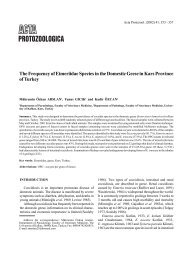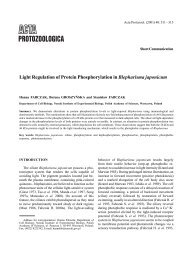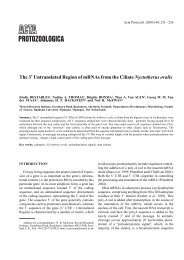The Centropyxis aerophila Complex (Protozoa: Testacea)
The Centropyxis aerophila Complex (Protozoa: Testacea)
The Centropyxis aerophila Complex (Protozoa: Testacea)
You also want an ePaper? Increase the reach of your titles
YUMPU automatically turns print PDFs into web optimized ePapers that Google loves.
<strong>The</strong> <strong>Centropyxis</strong> <strong>aerophila</strong> complex 271<br />
than in C. <strong>aerophila</strong> <strong>aerophila</strong> (28.9 vs. 24.9 µm).<br />
However, such result is expected and can be obtained<br />
with most living things, even with man, when intermediate<br />
specimens are removed. In fact, the experiment was<br />
performed specifically with the goal of obtaining information<br />
as to how previous authors probably distinguished<br />
Deflandre’s varieties (see next but one chapter).<br />
<strong>Centropyxis</strong> sylvatica is a distinct morphospecies<br />
We agree with Bonnet and Thomas (1955) that the lip<br />
perforation of C. sylvatica is difficult to observe and<br />
usually recognisable only in optimally orientated and<br />
transparent specimens. Indeed, when looking at an<br />
unorientated shell assemblage one gets doubts whether<br />
the lip perforation exists at all! And this doubt is strengthened<br />
by the fact that, contrary to Deflandre’s (1929)<br />
claim, C. sylvatica is obviously not larger than<br />
C. <strong>aerophila</strong> <strong>aerophila</strong> and C. <strong>aerophila</strong> sphagnicola<br />
(Figs. 62a - c), this being also evident from the size<br />
(69-72 x 67-73 µm) of the specimens studied by Bonnet<br />
and Thomas (1955). Nonetheless, the lip perforation<br />
exists and distinguishes C. sylvatica from the other<br />
varieties (Figs. 41 - 61). This conclusion is supported by<br />
the investigations of Lüftenegger et al. (1988) and<br />
Rauenbusch (1987). Furthermore, the lip perforation has<br />
been clearly shown, i.e. by scanning electron microscopy,<br />
in a larger, related species, <strong>Centropyxis</strong> matthesi<br />
Rauenbusch, 1987; and a similar, probably homologous<br />
opening occurs in Paracentropyxis mimetica Bonnet,<br />
1960. Thus, we agree with Bonnet and Thomas (1955,<br />
1960) that C. <strong>aerophila</strong> var. sylvatica should obtain<br />
species rank. It is well defined by its extraordinary lip<br />
perforation, forming a second, inner pseudostome.<br />
Much more difficult is the question whether<br />
C. sylvatica is a member of the genus <strong>Centropyxis</strong> at<br />
all! <strong>The</strong>re are at least two other, well-defined species<br />
with a distinct lip perforation, viz., <strong>Centropyxis</strong> matthesi<br />
and C. deflandriana. We cannot exclude that these<br />
three taxa represent a specific (homologous) evolutionary<br />
line different from that of <strong>Centropyxis</strong>, that is, it<br />
could happen that the similarities in shape and size of<br />
C. <strong>aerophila</strong> and C. sylvatica are an analogy. <strong>The</strong><br />
solution of this question will require genetic and molecular<br />
methods.<br />
How did previous authors distinguish Deflandre’s<br />
<strong>Centropyxis</strong> <strong>aerophila</strong> varieties<br />
As mentioned in the introduction, Deflandre’s varieties<br />
of C. <strong>aerophila</strong> have been reported by many<br />
testacean researchers from terrestrial and freshwater<br />
habitats worldwide, usually even from the same sample.<br />
Obviously, all used Deflandre’s traits to distinguish the<br />
varieties, at least none mentioned to have applied other<br />
and/or additional features. Furthermore, none mentioned<br />
having looked for the lip perforation, even after the<br />
pioneering paper of Bonnet and Thomas (1955), although<br />
it is the sole feature unequivocally separating<br />
C. <strong>aerophila</strong> sylvatica from C. <strong>aerophila</strong> <strong>aerophila</strong><br />
and C. <strong>aerophila</strong> sphagnicola.<br />
We showed that it is impossible to distinguish three<br />
varieties in C. <strong>aerophila</strong> with the morphological and<br />
morphometrical features given by Deflandre (1929); and<br />
our data give no indication that other, as yet undescribed<br />
reliable characteristics exist (Figs. 62a-d; Table 1). How<br />
then, could so many authors distinguish Deflandre’s<br />
varieties, although some mentioned problems (Jung 1936;<br />
Schönborn 1966, 1975; Chardez 1979) In our opinion it<br />
is because they considered mainly the extremes of a<br />
variability cline, which fit to Deflandre’s descriptions,<br />
obviously assigning intermediate specimens more or less<br />
arbitrarily to one of the varieties. We could also distinguish<br />
three taxa when we sorted out all intermediates,<br />
that is, about half of the shells (Figs. 62e, f; Table 2).<br />
A practicable solution for the problem:<br />
the “<strong>Centropyxis</strong> <strong>aerophila</strong> complex”<br />
<strong>The</strong> species problem in general and of testate amoebae<br />
in particular has been extensively investigated and<br />
discussed recently (Schönborn and Peschke 1988, Medioli<br />
et al. 1990, Schönborn 1992a, Foissner and Korganova<br />
1995, Bobrov et al. 1995, Wanner 1999). <strong>The</strong>se studies<br />
showed the lack of a simple answer and emphasised the<br />
need for thorough species descriptions and avoidance of<br />
infrasubspecific taxa, unless they can be proven by<br />
reliable morphological and/or morphometrical features.<br />
<strong>The</strong>y also showed that testacean shells are not extraordinarily<br />
variable, in contrast to the widespread believe,<br />
because the variation coefficients are hardly greater<br />
than in other organisms. This is emphasised by the<br />
present results (Tables 1, 2).<br />
We showed that it is impossible to distinguish varieties<br />
in C. <strong>aerophila</strong> with the features used by Deflandre<br />
(1929). <strong>The</strong> situation became even worse when the<br />
varieties described later were taken into account<br />
(for reviews, see Decloitre 1978, 1979).<br />
Basically, there are two ways to solve the problem.<br />
First, one might recognise only a single species, namely,<br />
<strong>Centropyxis</strong> <strong>aerophila</strong>, and classify all varieties and<br />
forms as falling into the species natural range of variability.<br />
Actually, this has been done by the describers of the



